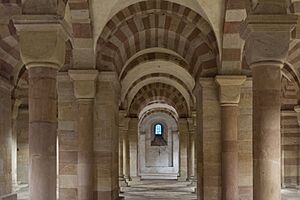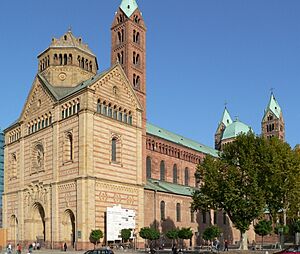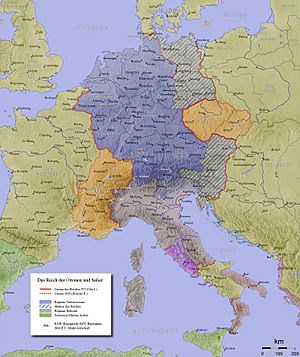Salian dynasty facts for kids
The Salian dynasty (also known as the Salier in German) was a powerful family in the High Middle Ages. They ruled as kings of Germany from 1024 to 1125. All four Salian kings also became Holy Roman emperors, ruling from 1027 to 1125.
After the last Ottonian emperor died in 1024, the Kingdom of Germany and then the entire Holy Roman Empire went to Conrad II. He was a Salian. Three more Salian rulers followed him: Henry III, Henry IV, and Henry V. They made their kingdom a very strong power in Europe. The Salians created a lasting system of government. It used public officials who reported directly to the king.
Quick facts for kids SaliansSalier
Reges salici
|
|
|---|---|

The crypt of Speyer Cathedral, the Salian emperors' burial place
|
|
| Parent family | Widonids (?) |
| Country | Holy Roman Empire Germany Italy Burgundy Carinthia Bavaria Swabia |
| Place of origin | Franconia |
| Founded | Early 10th century |
| Founder | Count Werner |
| Final ruler | Emperor Henry V |
| Members | Pope Gregory V Emperor Conrad II Emperor Henry III Emperor Henry IV |
| Connected families | Ottonian Hohenstaufen Babenberg |
| Distinctions | Investiture Controversy |
| Traditions | Roman Catholicism |
| Dissolution | 1125 |
Contents
Who Were the Salians?
Historians believe the Salians came from the Widonids. This was an important noble family from the 7th century. Their lands were near the Moselle and Saar rivers. They supported the Carolingians, another powerful family.
Wipo of Burgundy, who wrote about the first Salian emperor, Conrad II, described Conrad's family as "distinguished noble lords." They were from a region called Rhenish Franconia. Wipo also said Conrad's mother was "supposedly descended from the ancient royal house of Troy." This linked Conrad to the old Merovingian dynasty, who also claimed Trojan ancestors.
The name "Salian" likely came from the Salian Franks. They were a famous Frankish group. Their laws, known as the Salic law, were well-known. Another idea is that the name comes from an old German word sal, meaning "lordship." This fits because Salian rulers liked clear power structures.
The term reges salici (Salian kings) was probably first used in the early 12th century. A list of rulers from Mainz, finished around 1139–40, is the first to use it. Bishop Otto of Freising, who was related to the Salians, also used the term.
All male Salians who were not going into the Church were named Conrad or Henry. This tradition started with Otto of Worms in the late 10th century.
Early Salian Family Members
| Early Salians | ||||||||||||||||||||||||||||||||||||||||||||||||||||||||||||||||||||||||||||||||||||||||||||||||||||||||||||||||||||||||||||||||||||||||||||||||||||||||||||||||||||||||||||||||||||||||||||||||||||||||||||||||||||||||||||||||||||||||||||||||||||||||||||||||||||||||||||||||||||||||||||||||||||||||||||||||||||||||||||||||||||||||||||||||||||||||||||||||||||||||||||||||||||||||||||||||||||||||||||||||||||||||||||||||||||||||||||||||||||||||||||||||||||||||||||||||||||||||||||||||
|---|---|---|---|---|---|---|---|---|---|---|---|---|---|---|---|---|---|---|---|---|---|---|---|---|---|---|---|---|---|---|---|---|---|---|---|---|---|---|---|---|---|---|---|---|---|---|---|---|---|---|---|---|---|---|---|---|---|---|---|---|---|---|---|---|---|---|---|---|---|---|---|---|---|---|---|---|---|---|---|---|---|---|---|---|---|---|---|---|---|---|---|---|---|---|---|---|---|---|---|---|---|---|---|---|---|---|---|---|---|---|---|---|---|---|---|---|---|---|---|---|---|---|---|---|---|---|---|---|---|---|---|---|---|---|---|---|---|---|---|---|---|---|---|---|---|---|---|---|---|---|---|---|---|---|---|---|---|---|---|---|---|---|---|---|---|---|---|---|---|---|---|---|---|---|---|---|---|---|---|---|---|---|---|---|---|---|---|---|---|---|---|---|---|---|---|---|---|---|---|---|---|---|---|---|---|---|---|---|---|---|---|---|---|---|---|---|---|---|---|---|---|---|---|---|---|---|---|---|---|---|---|---|---|---|---|---|---|---|---|---|---|---|---|---|---|---|---|---|---|---|---|---|---|---|---|---|---|---|---|---|---|---|---|---|---|---|---|---|---|---|---|---|---|---|---|---|---|---|---|---|---|---|---|---|---|---|---|---|---|---|---|---|---|---|---|---|---|---|---|---|---|---|---|---|---|---|---|---|---|---|---|---|---|---|---|---|---|---|---|---|---|---|---|---|---|---|---|---|---|---|---|---|---|---|---|---|---|---|---|---|---|---|---|---|---|---|---|---|---|---|---|---|---|---|---|---|---|---|---|---|---|---|---|---|---|---|---|---|---|---|---|---|---|---|---|---|---|---|---|---|---|---|---|---|---|---|---|---|---|---|---|---|---|---|---|---|---|---|---|---|---|---|---|---|---|---|---|---|---|---|---|---|---|---|---|---|---|---|---|---|---|---|---|---|---|---|---|---|---|---|---|---|---|---|---|---|---|---|---|---|---|---|---|---|---|---|---|---|---|---|---|---|---|---|---|---|---|---|---|---|---|---|---|---|---|---|---|---|---|---|---|---|---|---|---|---|---|---|---|---|
|
||||||||||||||||||||||||||||||||||||||||||||||||||||||||||||||||||||||||||||||||||||||||||||||||||||||||||||||||||||||||||||||||||||||||||||||||||||||||||||||||||||||||||||||||||||||||||||||||||||||||||||||||||||||||||||||||||||||||||||||||||||||||||||||||||||||||||||||||||||||||||||||||||||||||||||||||||||||||||||||||||||||||||||||||||||||||||||||||||||||||||||||||||||||||||||||||||||||||||||||||||||||||||||||||||||||||||||||||||||||||||||||||||||||||||||||||||||||||||||||||
The first known ancestor of the Salian monarchs was Count Werner. He held lands in the Nahegau, Speyergau, and Wormsgau in the early 10th century. He married a relative of King Conrad I of Germany. This marriage brought the name Conrad into the family.
Werner's son, Conrad the Red, inherited his father's lands. He became a strong supporter of King Otto I. In 944 or 945, he was given the Duchy of Lotharingia. He married Otto I's daughter, Luidgard, in 947. This marriage connected the Salians to the royal Ottonian dynasty. Conrad the Red died fighting the Magyars in 955. He was buried in Worms Cathedral, which was unusual for someone who was not a bishop or king.
Conrad the Red's son, Otto of Worms, was favored by his grandfather, Emperor Otto I. Otto of Worms gathered many lands between the Rhine and Neckar rivers. Emperor Otto II was worried about his nephew's power. So, in 978, he sent Otto of Worms to rule the faraway Duchy of Carinthia. Otto of Worms later gave up some rights in Worms to the local bishop. He also gave up Carinthia but received other valuable lands and the title of duke. He was the first duke to have the title without ruling a duchy.
Salian Dukes and Bishops
| Salian dukes and bishops | ||||||||||||||||||||||||||||||||||||||||||||||||||||||||||||||||||||||||||||||||||||||||||||||||||||||||||||||||||||||||||||||||||||||||||||||||||||||||||||||||||||||||||||||||||||||||||||||||||||||||||||||||||||||||||||||||||||||||||||||||||||||||||||||||||||||||||||||||||||||||||||||||||||||||||||||||||||||||||||||||||||||||||||||||||||||||||||||||||||||||||||||||||||||
|---|---|---|---|---|---|---|---|---|---|---|---|---|---|---|---|---|---|---|---|---|---|---|---|---|---|---|---|---|---|---|---|---|---|---|---|---|---|---|---|---|---|---|---|---|---|---|---|---|---|---|---|---|---|---|---|---|---|---|---|---|---|---|---|---|---|---|---|---|---|---|---|---|---|---|---|---|---|---|---|---|---|---|---|---|---|---|---|---|---|---|---|---|---|---|---|---|---|---|---|---|---|---|---|---|---|---|---|---|---|---|---|---|---|---|---|---|---|---|---|---|---|---|---|---|---|---|---|---|---|---|---|---|---|---|---|---|---|---|---|---|---|---|---|---|---|---|---|---|---|---|---|---|---|---|---|---|---|---|---|---|---|---|---|---|---|---|---|---|---|---|---|---|---|---|---|---|---|---|---|---|---|---|---|---|---|---|---|---|---|---|---|---|---|---|---|---|---|---|---|---|---|---|---|---|---|---|---|---|---|---|---|---|---|---|---|---|---|---|---|---|---|---|---|---|---|---|---|---|---|---|---|---|---|---|---|---|---|---|---|---|---|---|---|---|---|---|---|---|---|---|---|---|---|---|---|---|---|---|---|---|---|---|---|---|---|---|---|---|---|---|---|---|---|---|---|---|---|---|---|---|---|---|---|---|---|---|---|---|---|---|---|---|---|---|---|---|---|---|---|---|---|---|---|---|---|---|---|---|---|---|---|---|---|---|---|---|---|---|---|---|---|---|---|---|---|---|---|---|---|---|---|---|---|---|---|---|---|---|---|---|---|---|---|---|---|---|---|---|---|---|---|---|---|---|---|---|---|---|---|---|---|---|---|---|---|---|---|---|---|---|---|---|---|---|
|
||||||||||||||||||||||||||||||||||||||||||||||||||||||||||||||||||||||||||||||||||||||||||||||||||||||||||||||||||||||||||||||||||||||||||||||||||||||||||||||||||||||||||||||||||||||||||||||||||||||||||||||||||||||||||||||||||||||||||||||||||||||||||||||||||||||||||||||||||||||||||||||||||||||||||||||||||||||||||||||||||||||||||||||||||||||||||||||||||||||||||||||||||||||
Henry of Worms was Otto of Worms's oldest son. His wife, Adelaide, came from a noble family in Lotharingia. Their son, Conrad, would become the first Salian emperor. Sadly, Henry died before his father, around 990 or 991.
After Henry's early death, his rights passed to his younger brother, Conrad of Carinthia. Conrad married Matilda of Swabia around 1002. In 1004, he became Duke of Carinthia, following his father. He died in 1011.
Pope Gregory V was another younger son of Otto of Worms. Emperor Otto III, Otto's cousin, made him pope in 996. Bruno, the first German pope, took the name Gregory V. He crowned Otto III as emperor that same year. Pope Gregory V died young, at age 26 or 27, in 999.
William of Strasbourg was Otto of Worms's youngest son. He became bishop of Strasbourg in 1028 or 1029. Strasbourg was one of the richest bishoprics in Germany. He died in 1046 or 1047.
Conrad the Younger was the older son of Duke Conrad I of Carinthia. He was born between 1002 and 1005. When his father died in 1011, Conrad was too young to rule. He inherited his father's lands, but Emperor Henry II appointed a new duke for Carinthia. After Emperor Henry II died in 1024, Conrad and his cousin, Conrad the Elder, both wanted the throne. Conrad the Elder was chosen as the new king.
The Imperial Salians
| Imperial Salians | ||||||||||||||||||||||||||||||||||||||||||||||||||||||||||||||||||||||||||||||||||||||||||||||||||||||||||||||||||||||||||||||||||||||||||||||||||||||||||||||||||||||||||||||||||||||||||||||||||||||||||||||||||||||||||||||||||||||||||||||||||||||||||||||||||||||||||||||||||||||||||||||||||||||||||||||||||||||||||||||||||||||||||||||||||||||||||||||||||||||||||||||||||||||||||||||||||||||||||||||||||||||||||||||||||||||||||||||||||||||||||||||||||||||||||||||||||||||||||||||||||||||||||||||||||||||||||||||||||||||||||||||||||||||||||||||||||||||||||||||||||||||||||||||||||||||||||||||||||||||||||||||||||||||||||||||||||||||||||||||||||||||||||||||||||||||||||||||||||||||||||||||||||||||||||||||||||||||||||||||||||||||||||||||||||||||||||||||||||||||||||||||||||||||||||||||||||||||||||||||||||||||||||||||||||||||||||||||||||||||||||||||||||||||
|---|---|---|---|---|---|---|---|---|---|---|---|---|---|---|---|---|---|---|---|---|---|---|---|---|---|---|---|---|---|---|---|---|---|---|---|---|---|---|---|---|---|---|---|---|---|---|---|---|---|---|---|---|---|---|---|---|---|---|---|---|---|---|---|---|---|---|---|---|---|---|---|---|---|---|---|---|---|---|---|---|---|---|---|---|---|---|---|---|---|---|---|---|---|---|---|---|---|---|---|---|---|---|---|---|---|---|---|---|---|---|---|---|---|---|---|---|---|---|---|---|---|---|---|---|---|---|---|---|---|---|---|---|---|---|---|---|---|---|---|---|---|---|---|---|---|---|---|---|---|---|---|---|---|---|---|---|---|---|---|---|---|---|---|---|---|---|---|---|---|---|---|---|---|---|---|---|---|---|---|---|---|---|---|---|---|---|---|---|---|---|---|---|---|---|---|---|---|---|---|---|---|---|---|---|---|---|---|---|---|---|---|---|---|---|---|---|---|---|---|---|---|---|---|---|---|---|---|---|---|---|---|---|---|---|---|---|---|---|---|---|---|---|---|---|---|---|---|---|---|---|---|---|---|---|---|---|---|---|---|---|---|---|---|---|---|---|---|---|---|---|---|---|---|---|---|---|---|---|---|---|---|---|---|---|---|---|---|---|---|---|---|---|---|---|---|---|---|---|---|---|---|---|---|---|---|---|---|---|---|---|---|---|---|---|---|---|---|---|---|---|---|---|---|---|---|---|---|---|---|---|---|---|---|---|---|---|---|---|---|---|---|---|---|---|---|---|---|---|---|---|---|---|---|---|---|---|---|---|---|---|---|---|---|---|---|---|---|---|---|---|---|---|---|---|---|---|---|---|---|---|---|---|---|---|---|---|---|---|---|---|---|---|---|---|---|---|---|---|---|---|---|---|---|---|---|---|---|---|---|---|---|---|---|---|---|---|---|---|---|---|---|---|---|---|---|---|---|---|---|---|---|---|---|---|---|---|---|---|---|---|---|---|---|---|---|---|---|---|---|---|---|---|---|---|---|---|---|---|---|---|---|---|---|---|---|---|---|---|---|---|---|---|---|---|---|---|---|---|---|---|---|---|---|---|---|---|---|---|---|---|---|---|---|---|---|---|---|---|---|---|---|---|---|---|---|---|---|---|---|---|---|---|---|---|---|---|---|---|---|---|---|---|---|---|---|---|---|---|---|---|---|---|---|---|---|---|---|---|---|---|---|---|---|---|---|---|---|---|---|---|---|---|---|---|---|---|---|---|---|---|---|---|---|---|---|---|---|---|---|---|---|---|---|---|---|---|---|---|---|---|---|---|---|---|---|---|---|---|---|---|---|---|---|---|---|---|---|---|---|---|---|---|---|---|---|---|---|---|---|---|---|---|---|---|---|---|---|---|---|---|---|---|---|---|---|---|---|---|---|---|---|---|---|---|---|---|---|---|---|---|---|---|---|---|---|---|---|---|---|---|---|---|---|---|---|---|---|---|---|---|---|---|---|---|---|---|---|---|---|---|---|---|---|---|---|---|---|---|---|---|---|---|---|---|---|---|---|---|---|---|---|---|---|---|---|---|---|---|---|---|---|---|---|---|---|---|---|---|---|---|---|---|---|---|---|---|---|---|---|---|---|---|---|---|---|---|---|---|---|---|---|---|---|---|---|---|---|---|---|---|---|---|---|---|---|---|---|---|---|---|---|---|---|---|---|---|---|---|---|---|---|---|---|---|---|---|---|---|---|---|---|---|---|---|---|---|---|---|---|---|---|---|---|---|---|---|---|---|---|---|---|---|---|---|---|---|---|---|---|---|---|---|---|---|---|---|---|---|---|---|---|---|---|---|---|---|---|---|---|---|---|---|---|---|---|---|---|---|---|---|---|---|---|---|---|---|---|---|---|---|---|---|---|---|---|---|---|---|---|---|---|---|---|---|
|
||||||||||||||||||||||||||||||||||||||||||||||||||||||||||||||||||||||||||||||||||||||||||||||||||||||||||||||||||||||||||||||||||||||||||||||||||||||||||||||||||||||||||||||||||||||||||||||||||||||||||||||||||||||||||||||||||||||||||||||||||||||||||||||||||||||||||||||||||||||||||||||||||||||||||||||||||||||||||||||||||||||||||||||||||||||||||||||||||||||||||||||||||||||||||||||||||||||||||||||||||||||||||||||||||||||||||||||||||||||||||||||||||||||||||||||||||||||||||||||||||||||||||||||||||||||||||||||||||||||||||||||||||||||||||||||||||||||||||||||||||||||||||||||||||||||||||||||||||||||||||||||||||||||||||||||||||||||||||||||||||||||||||||||||||||||||||||||||||||||||||||||||||||||||||||||||||||||||||||||||||||||||||||||||||||||||||||||||||||||||||||||||||||||||||||||||||||||||||||||||||||||||||||||||||||||||||||||||||||||||||||||||||||||
Conrad II: The First Salian Emperor
Conrad the Elder was the only son of Henry of Worms. After his father died young, Bishop Burchard of Worms raised him. In 1016, he married Gisela of Swabia. Both her parents were descendants of Charlemagne. Gisela had been widowed twice before.
Conrad the Elder was chosen as king of Germany on September 4, 1024. He was crowned in Mainz Cathedral four days later. When the citizens of Pavia, an Italian city, heard of the previous emperor's death, they destroyed the royal palace. They claimed no king could own it during the time between rulers. Conrad replied that "Even if the king died, the kingdom remained."
Some Italian nobles offered the throne to other European rulers. But most Italian bishops and nobles supported Conrad. After putting down a rebellion in Germany, Conrad marched to Italy. He was crowned king of the Lombards in Milan in March 1026. He quickly crushed any resistance. He then went to Rome and was crowned Holy Roman Emperor by Pope John XIX on March 26, 1027.
Henry III: A Strong Ruler
In 1028, Conrad II had his son, Henry III, elected and crowned king of Germany. Henry III believed strongly in the king's sacred power. During his rule, Speyer Cathedral was made even larger. It became the biggest church in Western Europe. Henry successfully controlled the dukes, which made the king's power stronger.
However, in Lorraine, this led to years of conflict. Henry won these struggles. In 1046, Henry ended a split in the Church, called the papal schism. He freed the Pope from relying on Roman nobles. This helped the Pope become more powerful across Europe. Henry's early death in 1056 was seen as a big loss for the Empire.

Challenges and Changes
The early Salians were successful because they worked closely with the Church. This policy started with Otto I. The Church gave them the support they needed to control rebellious dukes. But over time, the Church began to regret this close relationship.
This alliance broke down in 1075 during the Investiture Controversy. This was a big fight between the Pope and the Emperor. Pope Gregory VII demanded that Emperor Henry IV give up his power over the Church in Germany. The Pope also challenged the idea that kings ruled by divine right. He gained support from German nobles who wanted to limit the Emperor's power.
The Pope even said that church officials would be excommunicated (kicked out of the Church) if they supported Henry. In 1077, Henry IV traveled to Canossa in northern Italy. He went there to show he was sorry and to get forgiveness from the Pope. However, he later started appointing church officials again. He even arranged for an antipope (a rival pope) to be elected in 1080.
The fight between the king and the Pope led to a war. It lasted from 1077 until the Concordat of Worms in 1122. The rule of the last Salian emperor, Henry V, happened during the end of this big conflict.
The Concordat of Worms was an agreement. Henry V agreed that the Pope would appoint high church officials. But the German king kept the right to say no to the Pope's choices.
The Holy Roman Empire lost control of Italy for a while. The imperial crown became dependent on support from different noble groups. Feudalism became more common. Free people sought protection by promising loyalty to a lord. These powerful local rulers gained large lands and armies. They took over local government and built more castles. The most powerful of these local rulers became known as princes, not just dukes.
Under the feudal laws of the Holy Roman Empire, the king only had power over the vassals (loyal followers) in his own family's territory. He had no power over the vassals of other princes. Without the support of these once-independent vassals, and with the Church becoming more hostile, the king's power weakened.
So, the Investiture Contest made local power stronger in the Holy Roman Empire. This was different from France and England, where the king's power grew. The long fight also hurt the Empire's intellectual life. Learning was mostly in monasteries at this time. The Empire fell behind France and Italy in new developments. For example, no universities were founded in the Holy Roman Empire until the 14th century.
The first Hohenstaufen king, Conrad III, was a grandson of the Salian Henry IV, Holy Roman Emperor. Henry IV's daughter, Agnes, was the heir to the Salian lands. Her first marriage led to the royal and imperial Hohenstaufen dynasty. Her second marriage led to the ducal Babenberg rulers of the Duchy of Austria.
Salian Kings and Emperors
- Conrad II (1024–1039), crowned emperor on March 26, 1027
- Henry III (1039–1056), crowned emperor on December 25, 1046
- Henry IV (1056–1106), crowned emperor on March 31, 1084
- Conrad (III) (1087–1098), a king under his father Henry IV
- Henry V (1106–1125), crowned emperor on April 13, 1111
These dates show when they became king and when they were crowned emperor.
See also


